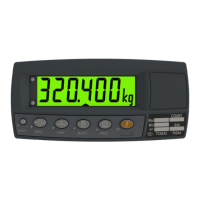Reference Manual V1.19 Software Versions 4.xx
Page 28 003R-682-119
7.1.1. ZERO (Zero Calibration Routine)
Press the <SEL> key to start. The display will show the current weight. Remove all weight
from the scale structure.
Press <SEL>, <EDT> or <OK> to execute a Zero Calibration. The display will show Z.in.P
to indicate that zeroing is in progress. When the process is complete the display will
return to weight to allow the zero to be checked.
Press the <ITM> key to leave the Zeroing routine or press <SEL>, <EDT> or <OK> to
repeat the operation.
7.1.2. SPAN (Span Calibration Routine)
Press <SEL> or <OK> to start. The display will show the current weight.
Use <EDT> to select whether the linearisation points need clearing CLr.L y, or not CLr.L
n. Press <OK> to continue.
Add the calibration test mass to the scale. The minimum acceptable span calibration
weight is 2% of the scale range. A weight this small may limit calibration accuracy. The
closer the test weight is to full scale the better the accuracy.
Press <SEL> or <OK> to show the calibration weight value. Change this to the correct
calibration weight using the <SEL> and <EDT> keys.
Press <OK> to trigger the Span Calibration routine. The display will show S.in P to
indicate that spanning is in progress. When the process is complete the display will
return to weight to allow the new weight reading to be checked.
When the Span Calibration is complete, press the <ITM> key to leave the Spanning
routine or press <SEL>, <EDT> or <OK> to re-edit the calibration weight and repeat
the operation.
7.2. Performing a Calibration with Direct mV/V Entry
In applications where test weights are not easily available, it is possible to calibrate the
instrument directly by entering the mV/V signal strength at Zero and full scale Span. The
Direct Zero setting (CAL:DIR.ZER) specifies a gross zero point for the scale. The Direct Span
setting (CAL:DIR.SPN) specifies the mV/V signal strength corresponding to an applied mass
equal to the full scale reading. This calibration technique is not compatible with linearisation.
Clearly the accuracy of this type of calibration is limited to the accuracy of the direct mV/V
data.
7.2.1. DIR.ZER (Direct Zero Calibration Entry)
Press the <OK> key to start. The display will show the current weight.
Press the <OK> key to enter the Direct Zero setting. Change the mV/V setting to the
correct value for Zero using the <SEL> and <EDT> keys.
Press the <OK> key to store the new zero calibration. When the process is complete the
display will return to weight to allow the new weight reading to be checked.
Press the <ITM> key to leave the Direct Zero routine or <OK> to repeat the operation.
7.2.2. DIR.SPN (Direct Span Calibration Entry)
Press the <OK> key to start. The display will show the current weight.
Press the <OK> key to enter the Direct Span setting. Change the mV/V setting to the
correct value for the full-scale signal strength, using the <SEL> and <EDT> keys.
Press the <OK> key to store the new span calibration. When the process is complete the
display will return to weight to allow the new weight reading to be checked.
Press the <ITM> key to leave the Direct Span routine or <OK> to repeat the operation.

